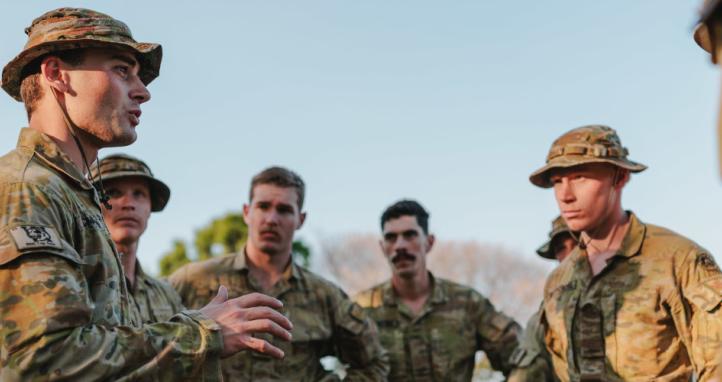Leading Planning and Planning Teams
So, you have been selected as the lead planner for staff planning. Whether single service, joint, or coalition planning, being a lead planner is a heart attack waiting to happen!
This article provides some advice for budding lead planners. It discusses how planning is about creating a narrative in an adversary’s mind. Developing this narrative requires problem-framing thinking. It then discusses the overall responsibility of the lead planner: to frame problems for others, the planners, to solve. Building on the above, the article explains how surprise and deception are innate to this planning narrative. Sometimes, they are relevant; other times, they are not.
Next, the article outlines how lead planners need a guiding concept to create any narrative effectively. Such a guiding idea enhances the lead planner’s capacity to facilitate planning and consultation. Key to such facilitation is effective peer leadership. The article concludes with seven tips that may assist lead planners in developing their skills, influence, and capacity to lead a team undertaking complex planning.
The first thing to understand as a lead planner is that all planning is the use of military art to create a narrative in the adversary’s mind. This narrative – often enacted through physical violence – seeks to shape the adversary’s thinking and behaviour in a certain way. As ADF-P-5 – Planning states, planning seeks to:
…influence and change an adversary’s behaviour. …[P]lanning develops methods to influence adversary decision-making to achieve the required behavioural change. …[P]lanning synchronises the kinetic and non-kinetic actions, and the lethal and non-lethal effects, of military power towards a unified narrative that seeks to change adversary thinking and behaviour. [Emphasis Added][1]
Storytelling is an analogy for the good planning of battles, campaigns, and wars. Lead planners are ‘telling’ a story to the adversary. Military actions, information operations, and kinetic strikes should all tell the same story. Actions should build to a clear and concise conclusion – the mission and end state. A good story also has clear stages of development: chapters (objectives), character arcs (lines of operations/effects), and tempo (phases). The lead planner’s sequencing of objectives and decisive actions are the chapters and paragraphs of the story, respectively.[2]
To create this narrative well requires a theory-of-mind of the adversary, or an understanding of how the adversary thinks and perceives the world.[3] Developing a theory-of-mind requires education, understanding, and a willingness to see the world from different points of view.[4] It requires problem-framing thinking.
A lead planner’s primary responsibility is to be a problem framer. Two broad worldviews influence thinking, planning, and the execution of the military arts. The first and easiest to understand is problem-solving. Problem-solving relates to War-as-Science thinking, or the belief that there are ‘…certain principles and rules guiding the conduct of war’.[5] Such thinking takes the identified problem as given. Based on this set problem, problem-solving thinking seeks to solve the problem using objective knowledge and tools. As such, problem-solving thinking is structured, functionalist, and deterministic. However, if the problem is poorly structured or ‘framed’ – as most real-world problems are – such thinking can undermine future action.[6] To frame these kinds of complex, real-world problems, War-as-Art thinking is required.
War-as-Art is the ‘…belief that reality does not conform to universal laws or principles.’[7] Such thinking uses theories and frameworks to consider the environment from different angles and perspectives. Through these multiple viewpoints, a common understanding of the different problems within the environment can be developed. This style of thinking is subjective, indeterminate, and accepts an unstructured view of the world.[8] The lead planner is the problem framer, while the planners are the problem solvers. The lead planner frames the environment and problems within, while the staff ‘fill in the details.’ The lead planner is the storyteller and primary author, and the staff are the sub-writers.
Within the metaphor of planning as storytelling, surprise and deception are parts of the narrative. Surprise and deception are ‘of the mind’ and are innate traits within planning and action. Sometimes, the story needs to be clear, concise, and direct – for example, a show of force. In such cases, surprise and deception undermine the story. Two historical situations illustrate this point. The first is the Cuban Missile Crisis (October 1962). The use of deception or surprise would have undermined President Kennedy’s attempts to deter the Soviet Union's efforts to position nuclear weapons within Cuba.[9] Instead, the United States was very overt in its military and diplomatic actions, both around Cuba and on the international stage.
An Australian example is the opening stages of the Regional Assistance Mission to the Solomon Islands (RAMSI; Operation ANODE). In 2003, HMAS MANOORA was stationed off the Solomon Islands as a display of RAMSI combat power. Here, RAMSI attempted to shape the Malaita Eagle Force through a show of strength and capability. In such a circumstance, deception and surprise would be counterproductive to the planning and actual ‘narrative’.[10] In other cases, a ‘great reveal’ is needed.
Sometimes, the adversary’s thinking must be led one way, while the plan sets up the final chapter. In such a case, deception is critical to create the Keyser Söze moment.[11] Once more, history is full of examples where deception and surprise have been crucial to the outcome. Two Allied operations of the Second World War highlight this: Operations MINCEMEAT and FORTITUDE. MINCEMEAT, sometimes known as the ‘man who never was’, was a key part of the planning narrative for the Allied invasion of Sicily.[12] Meanwhile, FORTITUDE helped hide the likely location of the Normandy Landings.[13] In both cases, deception and real planning were highly integrated.
Where possible, real preparations for the operation – force movements, logistics, and training – were part of the deception.[14] Neither of these deception plans was created in isolation. Instead, they were part of the wider plan’s narrative: force the adversary to think one thing while something else occurs, enabling the military to undermine the adversary’s will. Yet, how the adversary interprets that narrative is vital. On 7 December 1941, the Japanese attacked Pearl Harbour. Although the Japanese had several military objectives, one was to demoralise the United States through a Japanese surprise and show of strength, forcing the United States to sue for peace. It had the opposite effect. The key point here is this: planning as storytelling requires an understanding of the adversary, their commanders, and their perceptions of the world.
Key military theorists reinforce the concept of planning as a narrative. Sun Tzu is often referenced for his discussions on deception and surprise. Yet, a careful reading of Sun Tzu highlights that he never singles deception out for specific discussion. Rather, he reminds the reader that surprise and deception come from one’s estimate of the enemy. This estimate, or understanding of the adversary and environment, is the foundation of developing and executing plans, or the narrative within Sun Tzu’s metaphoric writing.[15]
A reading of the historical record illustrates that good lead planners must understand that all planning is the use of military art to create a narrative in the adversary’s mind.[16] Therefore, good lead planners must understand how to structure a plan to create a narrative that influences and/or coerces a desired perception in the adversary’s mind. Surprise and deception are just methods to influence this narrative. For the lead planner to effectively be a problem framer and guide this narrative development, the lead planner needs a conceptual plan first. Lead planners should never walk into a plans room without a plan.
Lead planners must have a guiding concept to shape planning and get the best out of staff and subordinate commands. The above may seem counter to all doctrine on the subject of planning. It is not. There is a need for consultation and eliciting many different views on the environment, problem space, and approach.[17] To get the best out of a group with diverse views, such consultation must be done right. The need for effectively managed consultation is particularly true when leading new teams and coalition groups. Having a guiding concept helps the lead planner facilitate planning and discussion.
The lead planner is both a team leader and a facilitator of group learning. The lead planner needs everyone to be on the ‘same page’ to enable planning. The best way to achieve this common understanding is to let people feel they have contributed and changed the group’s thinking about the problem space. Enabling this creative environment is key to peer leadership, achieved through facilitating and guiding discussion and action. Where this facilitation is done well, the lead planner gains influence within the planning group and broader organisation.
Effective facilitation is even more important in newly formed planning teams or coalition environments. The lead planner may not have explicit power (rank/command) over the staff in these situations. Facilitation of discussion, group learning, and individual planner input enables planning staff to feel they own the product, which increases the lead planner’s influence. Increased influence is an implicit form of power that gives the lead planner tacit authority to direct action when time is short.[18] The question for the lead planner is: how can such facilitation be achieved?
The following seven tips may assist a lead planner in framing problems for the plans team, guiding the plan’s development as a narrative, facilitating the planning team’s efforts, and enhancing the group’s learning and shared understanding. These tips are not exhaustive and should be tailored to the time available, experience, and influence.
-
Be the Storyteller of the Plan, and facilitator and guide for its detailed development. As already stated, sound planning is a story. The lead planner should have a concept of what the story is. Then, use the team to help ‘edit’ and ‘proofread’ the story. The team provides the story’s details, while the lead planner is the overall author.
-
Have a Plan. Spend some time reading the problem, framing it, and identifying what the initial end states and objectives are likely to be. Annex 2C of ADF-P-5 is a way of doing this.[19] Other techniques, like concept mapping, causal analysis, and similar methods, may also help. Although the Australian War College’s handbook, On Strategic Art, is pitched for strategy development, its Annex D may be helpful.[20] Annex D contains a series of Red Team and other tools and methods that may help a lead planner pull apart and consider the problem space from different perspectives. No matter the methods used, the lead planner must have the initial concept of the end state, objectives, and lines of operation/effort. This initial framing allows the lead planner to guide the planning team effectively.
-
Develop a Common Mental Model of the ‘Story’ – the Concept of Operations. With this initial framing in mind, the lead planner must help others to come to the same understanding. Spend time undertaking Design (sometimes called Scoping and Framing in some military doctrine) with all team members. Treat this scoping like a syndicate discussion. The lead planner may already have the ‘answer’. Through Design, the lead planner can help others come to similar conclusions.[21]
The above is particularly true for new teams or coalition environments. New teams have not formed an identity and common understanding of each other, let alone the problem space. Coalition plan rooms contain people from different nations, backgrounds, and doctrines. There may be a standard coalition procedure or doctrine (for example, NATO doctrine). Nevertheless, it is natural to revert to, normally tactical, national doctrines when the tempo increases.
Spending time undertaking guided Design is important because:
Suppose the lead planner tells the team the answer, particularly a new or coalition team. In that case, most people will likely not accept the initial framing. Therefore, the planners will not feel included and will not ‘own’ the planning and narrative.
If Design is not done with everyone, the team quickly silos into their areas of specialisation and interests. Such siloing leads to supporting concepts, such as logistics, joint fires, information operations, and others, not aligning with the overarching narrative. This misalignment of supporting concepts occurs because planners have developed their supporting concepts based on their perspective of the problem, not a common understanding of the problem.[22]
-
Design, done well, helps planners feel they came to the ‘answer’ themselves, with lead planner facilitation. Therefore, planners are likelier to ‘own’ the plan and narrative. This ownership is vital during back briefs to subordinate and senior commands, as well as national leadership in coalition environments.
-
Use Questions and be Socratic. As a guide and facilitator, you must elicit information from the group. Drawing out ideas and details from the team is essential. This process provides a common understanding across the planning group and updates, refines, and enhances the lead planner’s initial framing (or changing it; see next tip).[23] Such a process is known as a Socratic Dialogue. Through a Socratic dialogue, the lead planner helps the team develop a common understanding and provides the details for planning.
Experience helps develop the skills necessary for effective Socratic dialogues and leading questions. However, a good starting point is On Strategic Art. Chapter Five of the book explains why questions are useful in planning.[24] Annex C of On Strategic Art provides questions that could be adapted to tactical and campaign-level planning.[25] Finally, Annex D includes techniques to lead people through a discussion, including the five whys and the six hats.[26]
- Do Not Be Afraid to Change. If the lead planner finds their initial analysis was not perfect during Design and the development of a common mental model, change it! That is why the group is there. It is also why the lead planner does not show the group their initial framing. If, during detailed planning, a decisive action does not make sense over time, change it! If a supporting concept is wrong, direct it to change! Nothing should be ‘one and done’ during planning. New analysis and understanding should update the earlier framing.
-
Reverse SITREP Often. Once people have a common mental model and understand the broad lines of operation/effort, objectives, end state, and most of the decisive actions, it is time to let the planners loose on supporting concepts – usually while the lead planner focuses on tasks and effects for each Decisive Action. If not managed well, this period of disaggregated action can lead to divergent action. Therefore, ensure everyone comes together frequently to update where they are, what they are doing, and on any changes or issues they have found. Refer to Tip 5 if their changes are relevant. The timings of these back briefs will be context dependent. However, done well, such activities ensure the team remains on track and sustains a common mental model of the plan.
-
Do Not be Wedded to the Process. Doctrine is a guide. A military professional, grounded in the first principles theory of military art, can adapt doctrine to meet the situation, context, and time available. ADF-P-5 makes this point explicitly concerning military planning and the Military Appreciation Process.[27] Even in the “school house”, a good student of the military arts should adapt doctrine to the circumstances (just explain why to the Directing Staff!). The lead planner should review doctrine, consider the situation and context, and modify the process if it does not fit the problem or the team.
Good luck, lead planner. You are entering the wider world of the military arts.
End Notes
[1] Australian Defence Force, ADF-P-5 - Planning, ed. Lessons and Doctrine Directorate, 5 Series - Planning, (Canberra, ACT: Department of Defence, 2022), 5.
[2] As per ADF-P-5, Decisive Actions are defined as ‘a significant milestone that constitutes a key event or effect that, when executed or affected, allows the commander to gain a marked advantage, or contributes to achieving success.’ ADF-P-5 also outlines that the term ‘Decisive Actions’ is the generalised term for Decisive Events at the tactical level and Decisive Points in operational/campaign planning. See: Australian Defence Force, ADF-P-5, 29-30.
[3] A theory-of-mind is an individual’s or group’s capacity to determine the beliefs and likely intentions of others, based on the individual’s understanding of the “other”. The link between theory-of-mind and planning can be drawn from the discussion on military theorists and planning. John Boyd is an example of a military theorist who makes this point explicitly. From a broader perspective, a wide range of texts summarise theorists and draw out common themes, including the importance of understanding the enemy’s culture, thinking, and approach to battle and war. The definition of theory-of-mind comes from Bosio and Lyle. For the definition and illustrative examples of theorist analysis, see: John R. Boyd, A Discourse on Winning and Losing, 2018, with Introduction, Electronic (PDF) ed., ed. Grant T. Hammond (Maxwell, Alabama, USA: Air University Press, 1987); Michael I. Handel, Masters of War: Classical Strategic Thought, 3rd Revised and Expanded Kobo eBook ed. (Southgate, London, UK: Frank Cass Publishers, 2005); Jan Angstrom and Isabelle Duyvesteyn, eds., Understanding Victory and Defeat in Contemporary War, Contemporary Security Studies (Abingdon, United Kingdom: Routledge, 2007); Hew Strachan and Andreas Herberg-Rothe, eds., Clausewitz in the Twenty-First Century (Oxford, UK: Oxford University Press, 2007); Beatrice Heuser, The Evolution of Strategy: Thinking War from Antiquity to the Present (Cambridge, UK: Cambridge University Press, 2010); Lawrence Freedman, Strategy: A History (New York, USA: Oxford University Press, 2013); Dave Lyle, "The Cognitive Domain," in Personal Theories of Power: Exploring Strategy Through the Eyes of Emerging Leaders, ed. Nathan K. Finney et al. (Arlington, Virginia, USA: The Bridge, 2014), 9-10; Jan Angstrom and J.J. Widen, Contemporary Military Theory: The Dynamics of War (New York City, New York, USA: Routledge, 2015); Nicholas J. Bosio, Understanding War's Theory: What Military Theory Is, Where it Fits, and Who Influences It, ed. Australian Army Research Centre, vol. 001, Australian Army Occasional Paper - Conflict Theory and Strategy Series, (Canberra, ACT, AUST: Australian Army Research Centre, 2018), 30-31; Nicholas J. Bosio, "There is Only War: Understanding the Need for Balance Between Information and Physical Dimensions," Australian Army Research Centre ed. Land Power Forum, Australian Army, 07 May, 2019, https://researchcentre.army.gov.au/library/land-power-forum/there-only-war.
[4] Seeing and using different worldviews for thinking and action is known as a pluralist habit-of-mind. The literature on this is broad. See the following for pluralist habits-of-mind within the military context: Henry G. Gole, The Road to Rainbow: Army Planning for Global War, 1934-1940 (Annapolis, Maryland, USA: Naval Institute Press, 2003), 158; Williamson Murray, Military Adaptation in War: With Fear of Change, Kobo eBook ed. (New York, New York, USA: Cambridge University Press, 2011), 1.3-5, 4.28-35; Williamson Murray, War, Strategy, and Military Effectiveness, Kobo eBook ed. (New York, New York, USA: Cambridge University Press, 2011), 6.1-56 (Ch 6), 7.13-15; Peter R. Mansoor, "US Grand Strategy in the Second World War," in Successful Strategies: Triumphing in War and Peace from Antiquity to the Present, ed. Williamson Murray and Richard Hart Sinnreich (Cambridge, England, UK: Cambridge University Press, 2014), 11.48 (Habit of Thinking); Nicholas J. Bosio, "An Analysis of the Relationship between Contemporary Western Military Theory, Systems Thinking, and their Key Schools-of-Thought" (Doctor of Philosophy Doctorate (research), Australian National University, 2022), 58-60, 223, 56-62, http://hdl.handle.net/1885/260048.
[5] Milan N. Vego, "Science vs the Art of War," Joint Force Quarterly, no. 66 (2012): 67.
[6] This is summarised in the following two works: Bosio, "Relationship between Military Theory and Systems Thinking," 107-10, 222, 24-27; Nicholas J. Bosio, On Strategic Art: A Guide to Strategic Thinking and The Australian Strategy Formulation Framework, ed. Australian War College (Canberra, ACT, Australia: Australian War College, 2024), 20-21, 23-24. https://theforge.defence.gov.au/sites/default/files/2024-11/On%20Strategic%20Art%20-%20A%20Guide%20to%20Strategic%20Thinking%20and%20the%20ASFF%20%28Electronic%20Version%29.pdf.
[7] Vego, "Science vs Art," 62.
[8] Bosio, "Relationship between Military Theory and Systems Thinking," 107-10, 222, 24-27; Bosio, On Strategic Art, 20, 22-24.
[9] Freedman, Strategy: A History, 172-75, 89-90; Sergey Radchenko, "Strategies of Détente and Competition: Brezhnev and Moscow’s Cold War," in The New Makers of Modern Strategy: From the Ancient World to the Digital Age, ed. Hal Brands (Princeton, New Jersey, USA: Princeton Unviersity Press, 2023), 821-22.
[10] The author is indebted to Major Julian Storm for this example and insight.
[11] This is a reference to the movie The Usual Suspects and the villain. Beware, potential spoilers: the movie plot (narrative) is how Keyser Söze plays on an individual’s worldview and what they want to see to mask their existence.
[12] Operation MINCEMEAT was a part of Operation BARCLAY, the overall deception plan for the invasion of Sicily. This plan was heavily integrated into Operation HUSKY (the actual invasion plan) so that both real and decoy forces appeared to be targeting Greece and the Eastern Mediterranean. This caused German forces to reinforce these areas, opening Sicily to invasion.
[13] Operation FORTITUDE was a part of Operation BODYGUARD, the overall deception plan for Operation OVERLORD (Normandy Landings). FORTITUDE leveraged real and decoy forces, as well as real sustainment build up and preparations, to convince the German High Command that the landings would occur in Calais.
[14] This is a simplified overview of the intent and actions of these plans used for illustrative purposes.
[15] See Sun Tzu’s chapters ‘Estimates’ and ‘Waging War’. Sun Tzu, The Art of War, trans. Samuel B. Griffith (London, England, UK: Oxford University Press, 1963), 63-78.
[16] Liddell Hart makes this point specifically in discussing the ‘indirect approach’ to war and battle. Handel draws this concept out throughout his seminal work. Also see Angstrom and Widen for a summary of relevant military theory. See: Basil H. Liddell Hart, Strategy, 2nd Revised (1st Meridian) ed. (London, UK: Meridian, 1967; repr., Meridian 1991), 144-47, 324-29; Handel, Masters of War; Angstrom and Widen, Contemporary Military Theory, 60, 86-88, 172-74.
[17] Design, within military planning, seeks to make different perspectives and mental models explicit. This allows lead planners to identify the commonalities and differences and create a common mental model across the planning group and subordinate commands. For a brief discussion on this, see Bosio, On Strategic Art, 47-49.
[18] The concept of receiving tacit power from the transfer of authority from the group to the individual, or lead planner in this case, is summarised in: John C. Turner, "Explaining the Nature of Power: A Three-Process Theory," European Journal of Social Psychology 35, no. 1 (2005): 9-11; John C. Turner, Katherine J. Reynolds, and Emina Subasic, "Identity Confers Power: The New View of Leadership in Social Psychology," in Public Leadership: Perspectives and Practices, ed. Paul Hart and John Uhr (Canberra, ACT, AUST: ANU Press, 2008), 66-67; Nicholas J. Bosio, "What 'RIGHT' Looks Like: Linking Command and Moral Authority," Australian Defence College ed. The Forge, Australian Defence College, 19 August, 2020, https://theforge.defence.gov.au/publications/what-right-looks-linking-command-and-moral-authority.
[19] Australian Defence Force, ADF-P-5, 46-49.
[20] Bosio, On Strategic Art, 127-48.
[21] Design is a framework that makes divergent mental models explicit, identifies commonalities and differences, and helps build a common mental model. A summarised discussion on the theory of Design is provided in Bosio, On Strategic Art, 47-49.
[22] This is a common trait of falling into the belief that planning is a set process. Although focused on strategy, On Strategic Art makes this point when discussing Strategy-as-Process. This approach is applicable to planning at any level. See: Bosio, On Strategic Art, 33-34.
[23] See discussion on Design in the previous footnote and reference to On Strategic Art.
[24] Bosio, On Strategic Art, 66-67.
[25] Bosio, On Strategic Art, 121-26.
[26] The two techniques listed are explained in Bosio, On Strategic Art, 135-38.
[27] Australian Defence Force, ADF-P-5, 74.









